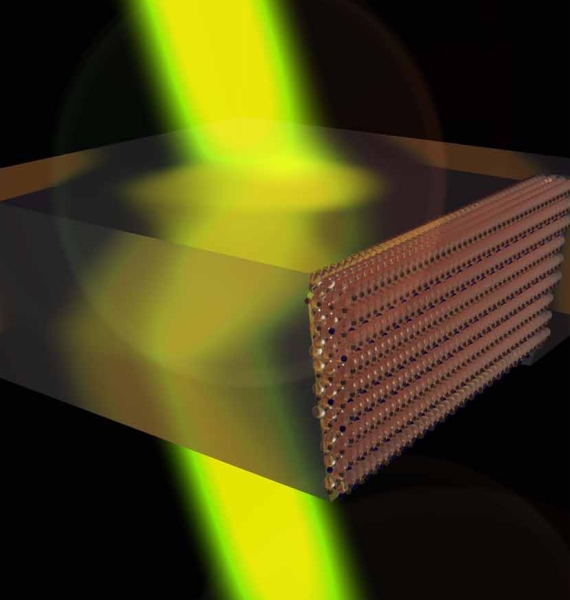August 5, 2013
WEST LAFAYETTE, Ind. — Researchers are working on a range of options to overcome a fundamental obstacle in commercializing "plasmonic metamaterials" that could bring advanced optical technologies for more powerful computers, new cancer treatments and other innovations.
The materials could make it possible to harness clouds of electrons called "surface plasmons" to manipulate and control light. Plasmonic materials under development now rely on the use of metals such as gold and silver, which absorb too much light for devices to be practical and are said to be "lossy" for this reason. They also are not compatible with the complementary metal–oxide–semiconductor (CMOS) manufacturing process used to construct integrated circuits.
"However, there are many alternative materials other than conventional metallic components that exhibit metallic properties and provide advantages in device performance," said Gururaj V. Naik, who is involved in the research and received a doctoral degree in electrical and computer engineering last month from Purdue University.
Alternative materials range from specially "doped" semiconductors, to transparent electrically conductive oxides and ultrathin layers of carbon called graphene.
An article about the materials was featured on the June cover of the journal Advanced Materials. The article provided a summary of recent developments in the search for better plasmonic materials and an outlook of further research directions. It was authored by Naik, Alexandra Boltasseva, a Purdue University associate professor of electrical and computer engineering, and Vladimir M. Shalaev, scientific director of nanophotonics at Purdue's Birck Nanotechnology Center, a distinguished professor of electrical and computer engineering and a scientific adviser for the Russian Quantum Center.
Plasmonic materials are promising for various potential advances, including more powerful microscopes; sensors; new types of light-harvesting systems for more efficient solar cells; computers and consumer electronics that use light instead of electronic signals to process information; cancer treatment; data storage; and even a cloak of invisibility.
Shalaev and Boltasseva have formed a startup company, Nano-Meta Technologies Inc., based at the Purdue Research Park. The company recently received $1 million in first-round funding from the venture capital firm Quantum Wave Fund to advance its early-stage technology. Nano-Meta Technologies is focusing initially on two applications: a new type of magnetic storage technology for computers and a new cancer-treatment approach.
The researchers have proposed replacing metals in plasmonic materials with a host of alternatives, sidestepping the limitations of gold and silver.
"As far as I know we are the first to address this issue of lossy metals and come up with alternative materials," Shalaev said.
The researchers are working to replace silver and gold in materials that are created using two options: making semiconductors more metallic by adding metal impurities to them; or adding non-metallic elements to metals, in effect making them less metallic. Examples of these materials include zinc oxides and titanium nitride.
The Purdue researchers propose using titanium nitride instead of metals for the data-storage concept. Because it has a higher melting point than gold or silver, it is especially promising for the technology, which works by using heat to record information on a magnetic disk. Unlike gold and silver, titanium nitride is CMOS compatible. Nano-Meta Technologies is developing prototype hard-drive heads.
In the cancer-treatment concept, tiny titanium nitridenanoparticles might be injected into the bloodstream so that they accumulate in tumors. Clinicians might shine a certain wavelength of light on these nanoparticles from outside the body, causing the particles to heat up and killing the cancer cells.
Information about Nano-Meta Technologies is available online at http://www.nanometatech.com/home.php
"We are especially excited about using our materials to enable the next generation of ultra-high-capacity computer hard drives," said Don Stocks, vice president of business operations at Nano-Meta Technologies.
The heat-assisted magnetic recording (HAMR) drives promise far greater capacity than is possible with current technology, he said.
"The most difficult challenge faced by the industry is identifying a robust and reliable plasmonic heat source with the necessary optical properties," Stocks said. "We believe we have a solution to this problem. Our CMOS-compatible plasmonic materials exhibit optical properties similar to gold with the added advantage of being very mechanically and thermally durable."
Lenses made of traditional materials can't focus light onto a spot smaller than half its wavelength. The company is developing nanostructured compounds that can concentrate light through plasmonic effects to bypass this hurdle, called the diffraction limit, which restricts the resolution of light microscopes and lithography.
Some new materials are showing promise in uses involving near-infrared light, the range of the spectrum critical for telecommunications and fiberoptics. Other materials also might work for light in the visible range of the spectrum.















